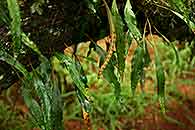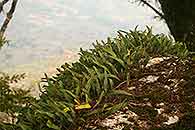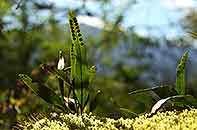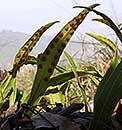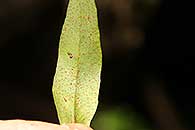Pleopeltis macrocarpa (Bory ex Willd.) Kaulf.
Synonyms |
Polypodium lanceolatum L. |
|---|---|
Common name |
|
Description |
Rhizome widely creeping, slender, ± 2 mm in diameter; rhizome scales lanceolate to ovate, peltate, brown with a darker central stripe and pale, lacerate margins, 2-3 mm long. Fronds spaced apart (up to 2.5 cm), simple, fleshy. Stipe up to 8 cm long, grey-brown, winged in the upper part, articulated to the rhizome, with a few scales with dark centre when young, becoming glabrous with age. Lamina evergreen, narrowly elliptic or linear-lanceolate in outline, gradually tapering towards base and apex, margins entire to weakly wavy, less often slightly to distinctly pinnatifid, up to 20 × 1.7 cm; upper surface subglabrous, lower surface with several circular to lanceolate, peltate scales under 1 mm long, with dark centre and jagged margins. Sori round to oval, up to 5 mm in diameter, placed in 2 rows between costa and margin in the upper third to half of the lamina, exindusiate, covered with scale-like paraphyses when young. |
Notes | Can be distinguished from Lepisorus schraderi and L. excavatus by the prominent scales set on the undersurface of the lamina. Microgramma mauritiana has sori set on the lower part of the lamina (not the upper) and is glabrous. |
Derivation | makros: large, karpon: fruit; referring to the large sori. |
Habitat | Moist coastal, riverine and montane forest or in moist woodland and scrub, moderately to deeply shaded. |
Distribution worldwide | Africa, tropical and S America, Hawaii, India, Réunion, Madagascar, Mascarene Is., St. Helena, Juan Fernandez and Tristan da Cunha. |
Distribution in Africa |
Angola, Burundi, Cameroon, Dem. Republic of Congo, Equatorial Guinea (incl. Bioko), Ethiopia, Guinea, Ivory Coast, Kenya, Lesotho, Liberia, Malawi, Mozambique, Nigeria, Rwanda, Sierra Leone, Somalia, South Africa, Swaziland, Tanzania , Uganda, Zambia, Zimbabwe. |
Growth form |
Epiphytic, lithophytic. |
Literature |
|

